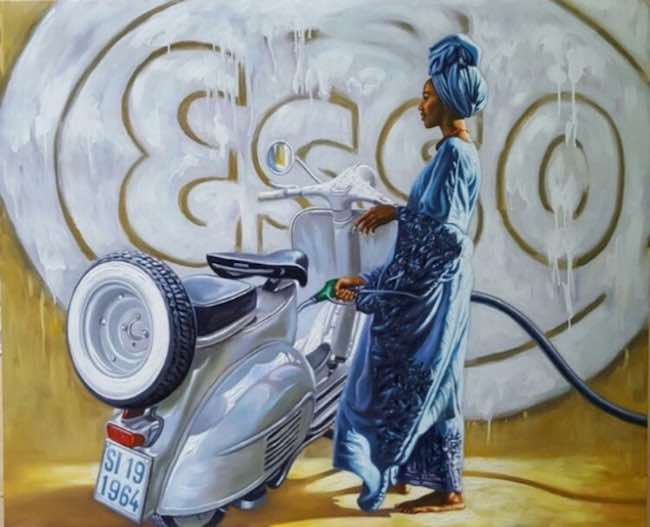Lo studio e l’analisi profonda della società attuale non può non condurre gli artisti a evidenziare una spaccatura non solo tra culture occidentali e orientali, ma anche tra passato e presente, come se fosse quasi naturale considerare gli elementi divisi e di conseguenza anelare un’unione che spesso fa fatica a verificarsi, inducendo per questo i creativi a sottolineare le problematiche di tale mancanza di apertura oppure a narrare ciascuno le proprie radici, i propri usi e costumi gridando l’esistenza di un mondo differente che ha bisogno di essere osservato con sguardo diverso. Ma vi sono anche alcuni artisti che, al contrario, cercano un punto di unione improbabile e immaginato che attraverso il loro sguardo può divenire immediatamente possibile, dimostrando così che i limiti sono imposti solo dalla razionalità, dalla chiusura nei confronti di ciò che è solo apparentemente distante e inconciliabile. Il protagonista di oggi attraverso il suo ironico e affascinante stile pittorico, riesce a unire mondi e culture differenti dimostrando che attraverso il linguaggio dell’arte tutto può essere possibile.
Gli anni Cinquanta del Novecento videro l’affermarsi di un movimento pittorico che si proponeva di ritornare alla figurazione, dopo decenni in cui l’astrazione e la rilevanza del concetto privo di riferimenti conosciuti all’occhio avevano dominato la scena internazionale, perché di fatto si stava concretizzando l’esigenza di parlare alla nuova borghesia emergente, spesso non così tanto preparata culturalmente da poter comprendere linguaggi tanto intellettuali; Andy Warhol ebbe l’intuizione che fosse giunto il momento di dare vita a una cifra pittorica facilmente comprensibile, in grado di rivoluzionare il punto di vista trasformando in opere d’arte le nuove icone del cinema, del mondo della politica, e i simboli del consumismo; l’obiettivo del creatore della Pop Art era quello di permettere a tutti di poter avere un’opera d’arte nella propria abitazione, anche a coloro che non avrebbero mai potuto acquistare un pezzo unico, ideando così la produzione in serie limitata denominata serigrafia. Lo sguardo di Warhol sulla società statunitense era ironica quanto dissacrante perché al di là delle patinate e affascinanti immagini si nascondeva una forse inconsapevole ma sagace analisi dell’orientamento effimero verso cui i valori si stavano spostando. Ma ciò che decretò il suo successo fu la capacità di parlare al grande pubblico, semplificando le immagini, rendendo iconici persino i prodotti di largo consumo che contraddistinguevano il potere d’acquisto della middle class che contribuì a renderlo non solo celebre ma anche uno dei più quotati artisti viventi della sua epoca. Attualizzare il cammino tracciato da Andy Warhol è una sfida su cui molti artisti contemporanei cercano di misurarsi perché in fondo esistono molti modi di declinare il tema della Pop Art, ciascuno attraverso la propria sensibilità, il proprio approccio alla vita e secondo il messaggio che vuole lasciare al pubblico. Romero Britto, Takashi Murakami, Jeff Koons, James Rosenquist, Jasper Johns, hanno tutti trovato un proprio personale modo di interpretare questo stile pittorico.
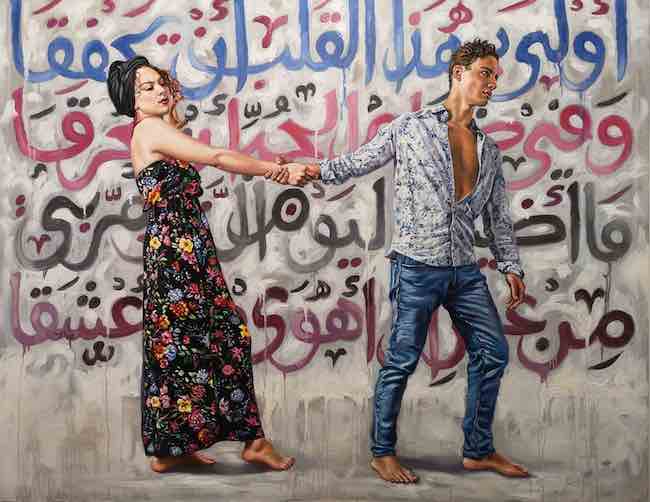
L’artista di origini libanesi Ali Hassoun è cresciuto artisticamente in Italia, si è formato all’Accademia di Belle Arti di Firenze e poi si è trasferito a Milano per incrementare e consolidare la sua carriera, dunque la sua storia personale lo colloca naturalmente a metà tra due culture, quella italiana e quella araba, a cui si aggiunge anche la sua predilezione per un linguaggio figurativo comprensibile ovunque senza che l’interpretazione sia ostacolata dal blocco linguistico. Elabora così nel tempo quella che è la sua caratteristica Pop Art, una visione colta e ironica su un mondo diviso, eppure unito, da modi di vivere e di affrontare l’esistenza lontani e divergenti forse solo perché non è nell’interesse dei potenti della terra trovare un punto di dialogo, una sinergia attraverso la quale la diversità possa costituire un arricchimento reciproco.
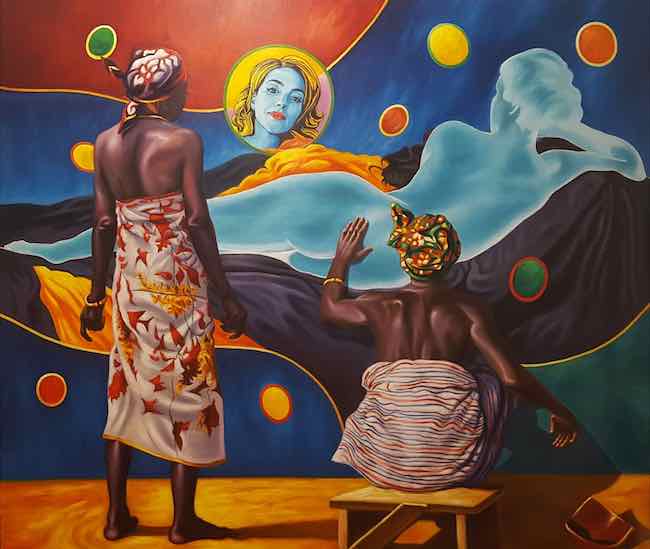
E dunque lo fa lui con la sua arte, con il suo tocco iperrealista necessario a generare una realtà parallela e a volte divertente in cui le differenze convivono, si fondono e i suoi personaggi camminano fianco a fianco, divengono protagonisti della creazione di qualcosa già creato oppure interpreti improbabili di opere d’arte del passato che si riattualizzano grazie alla sua creatività; le persone sembrano vive, tutto appare incredibilmente reale, come se fosse naturale quella fusione culturale, o forse suggerendo la via per poterla creare attraverso l’arte, l’unica in grado di superare le barriere, le spaccature, le incomprensioni, le divisioni che troppo spesso sono generate dal timore e dalla mancanza di conoscenza. Così Ali Hassoun invita l’occidente a scoprire il fascino dell’oriente e il suo desiderio di avvicinarsi alle innovazioni tecnologiche, alle icone che hanno segnato la storia della società ma anche la sua tradizione artistica; d’altro canto però invita l’oriente a interagire in maniera più profonda proprio con tutto ciò che in un mondo forse più conservatore può costituire una destabilizzazione, una velata minaccia a un ordine e a un ritmo più lento, più meditativo.
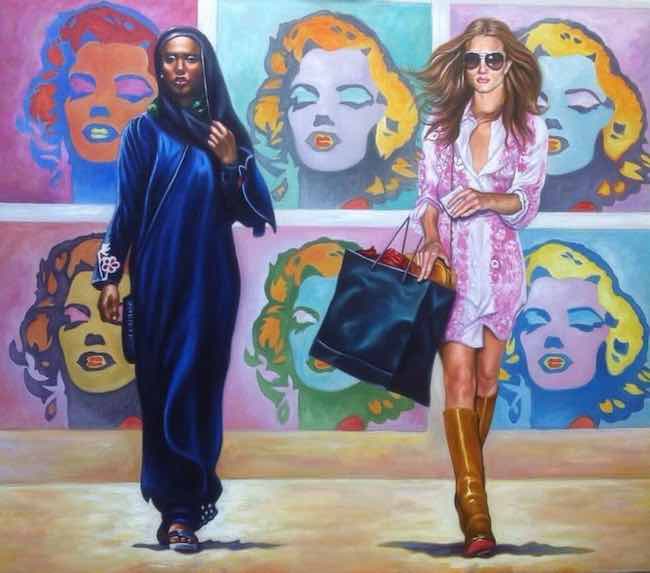
La serie Pop Girls è dedicata proprio a un incontro di culture, quella più tradizionale e quella più moderna, in cui entrambe le donne protagoniste appaiono disinvolte, affascinanti, a proprio agio nei loro abiti e nel loro modo di essere, come se si trovassero all’interno di un mondo ideale in cui non esistono limiti sociali, giudizio, e a cui fa da sfondo l’arte, quella di Andy Warhol evocato da Hassoun attraverso uno dei suoi multipli più iconici dedicato a Marylin Monroe.
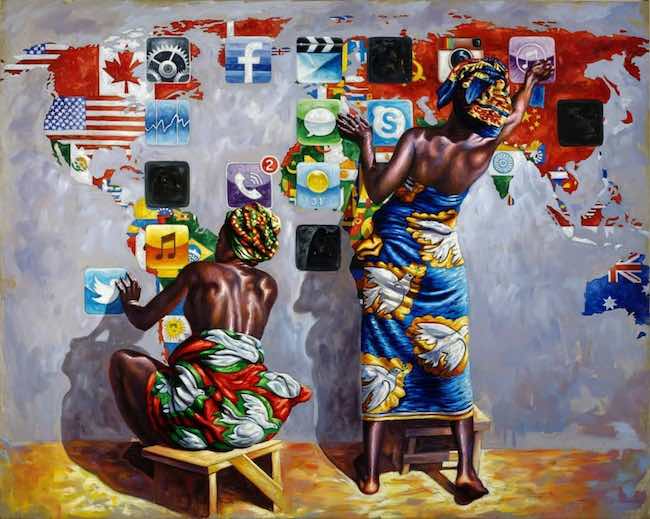
Nella serie Icons racconta invece dell’Africa, della semplicità e spontaneità di un paese che ha bisogno di correre verso il progresso già realtà nei paesi più tecnologicamente avanzati, dunque in queste opere Ali Hassoun mostra la naturale curiosità delle due donne protagoniste nei confronti delle icone di un iPhone, appartenente alla cultura occidentale e oggetto desiderato da tutti, ma anche dell’impossibilità di spostarle quelle icone, ingrandirle come verrebbe spontaneo a chi è abituato a usare questi oggetti tecnologici, malgrado non riescano poiché si tratta solo di un affresco su un muro; emerge in queste tele la convinzione che vi sia un istinto spontaneo che induce le donne a sapere perfettamente cosa fare di quei simboli ma un’oggettiva impossibilità a poterlo fare.
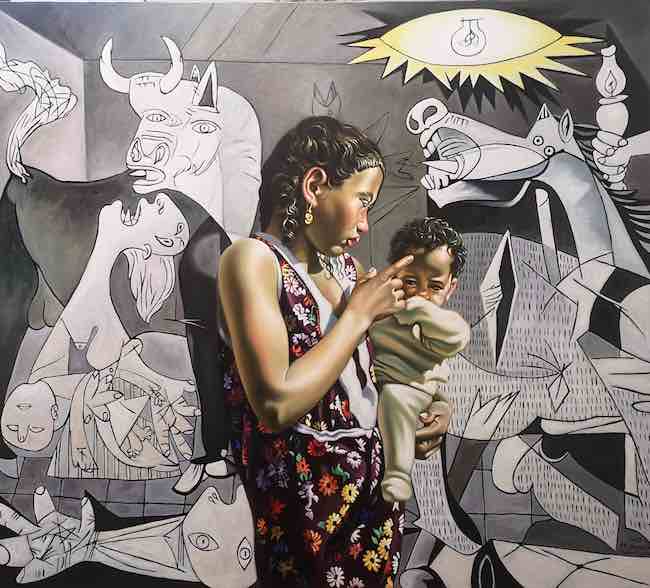
In Omaggio a Picasso invece mescola la storia dell’arte, o meglio un pittore che ha scritto pagine importanti nell’arte del Novecento, a una mamma con bambino nordafricani, nella loro spontaneità e inconsapevolezza di trovarsi davanti a uno dei dipinti più iconici e famosi al mondo; lo sguardo di Ali Hassoun si concentra sul bambino che sembra scrutare l’osservatore quasi a domandare quale sarà il suo futuro, come se la sua fosse una silenziosa richiesta di avere la possibilità di accedere alla conoscenza della bellezza dell’arte. La mamma si pone come variabile determinante, dipenderà da lei quanto il suo piccolo potrà avere di positivo nella vita, dunque in qualche modo l’artista riconosce all’individuo di qualsiasi razza o religione, il libero arbitrio di scegliere tra chiusura e desiderio di ascoltare ed entrare in connessione con una cultura diversa ma non per questo meno positiva, affascinante, educativa.
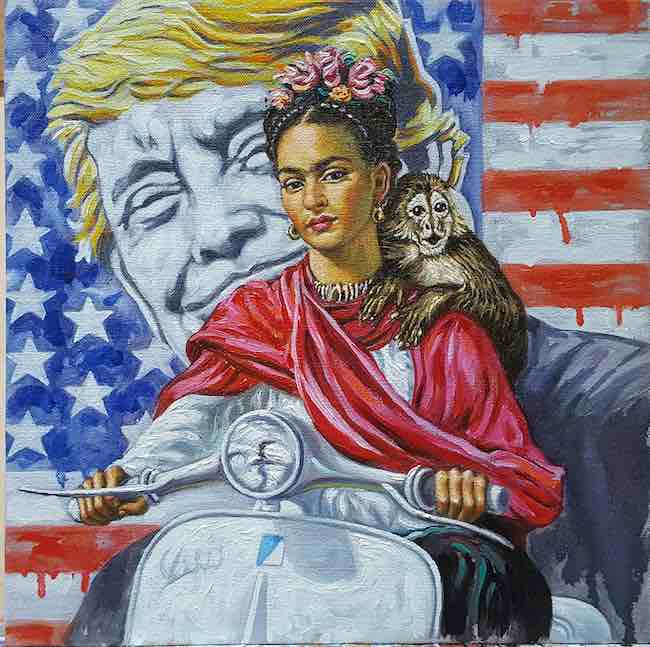
E ancora Hassoun gioca con l’arte del passato trasformando le icone più riconoscibili in personaggi contemporanei in grado di costituire quel ponte intertemporale che li indurrebbe forse a combattere le battaglie attuali con la stessa forza e determinazione con cui avevano combattuto nel loro tempo; nel dipinto Just for 2 days la protagonista Frida Kahlo è in sella a una Vespa, simbolo italiano, davanti a un poster di Donald Trump e lo sguardo della grande pittrice del Novecento sembra essere ironico, sarcastico nei confronti di chi ha voluto ostacolare l’ingresso dei suoi concittadini, i messicani, nel territorio statunitense così lei oltrepassa l’ostacolo sedendo orgogliosamente su un mezzo di locomozione in cui non tenta neanche di nascondersi, sfidando il presidente a fermarla.
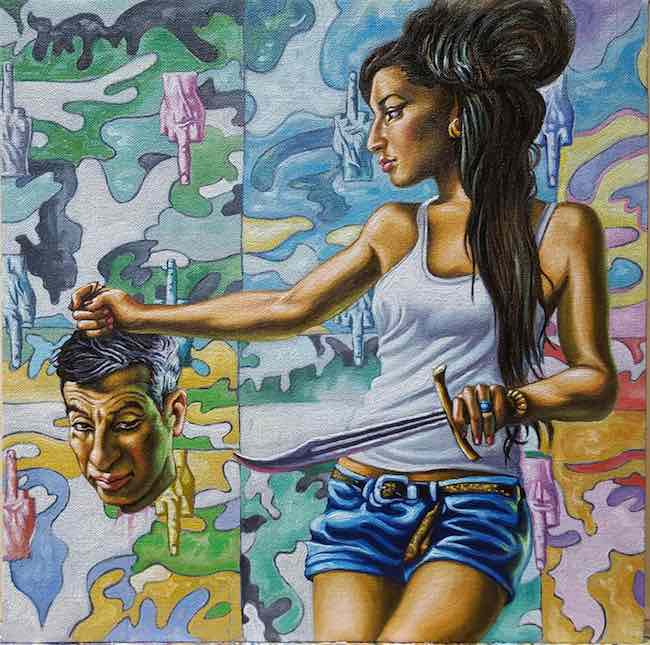
In una delle opere più riprodotte dai pittori figurativi di ogni tempo, Giuditta e Oloferne, rende invece protagonista una forte Amy Winehouse, in contrasto dunque con la sua reale fragilità che ne ha causato la precoce morte, che tiene in mano la testa di Maurizio Cattelan, quasi a voler sottolineare quanto i ruoli possano sovvertirsi se solo si avesse il coraggio di guardare le cose da un altro punto di vista. Ali Hassoun ha effettuato un percorso artistico molto importante, è quotato in asta e ha collezionisti in tutto il mondo; da qualche anno è rappresentato dalla Galleria Guastalla di Milano.
ALI HASSOUN-CONTATTI
Email: ali.hassoun64@gmail.com
Sito web: https://www.alihassoun.it/language/it/
Facebook: https://www.facebook.com/ali.hassoun.180
https://www.facebook.com/alihassounpainter
Instagram: https://www.instagram.com/alihassoun64/
Irony and mixture of cultures in Ali Hassoun’s Pop Art, a bridge between different civilisations
The study and in-depth analysis of today’s society cannot fail to lead artists to highlight a rift not only between Western and Eastern cultures, but also between past and present, as if it were almost natural to consider the elements divided and consequently yearn for a union that often struggles to take place, leading creative artists to emphasise the problems of this lack of openness or to narrate each one’s own roots, customs and traditions, shouting out the existence of a different world that needs to be observed with a different gaze. But there are also some artists who, on the contrary, seek an improbable and imagined point of union that through their gaze can become immediately possible, thus demonstrating that limits are only imposed by rationality, by closure towards what is only apparently distant and irreconcilable. Today’s protagonist, through his ironic and fascinating painting style, succeeds in uniting different worlds and cultures, demonstrating that through the language of art anything can be possible.
The 1950s saw the emergence of a pictorial movement that proposed a return to figuration, after decades in which abstraction and the relevance of the concept with no known references to the eye had dominated the international scene, because the need to speak to the new emerging middle class, often not so culturally prepared as to be able to understand such intellectual languages, was taking shape; Andy Warhol had the intuition that the time had come to give life to an easily comprehensible pictorial figure, capable of revolutionising the point of view by transforming the new icons of the cinema, the world of politics, and the symbols of consumerism into artwork; the aim of the creator of Pop Art was to allow everyone to have a piece of art in their home, even those who would never have been able to buy a unique piece, thus devising the limited series production called silk-screen printing.
Warhol’s gaze on American society was as ironic as it was desecrating because beyond the glossy and fascinating images lay a perhaps unconscious but shrewd analysis of the ephemeral orientation towards which values were shifting. But what decreed his success was his ability to speak to the general public, simplifying images, making iconic even the consumer products that characterised the purchasing power of the middle class, which contributed to making him not only famous but also one of the most highly regarded living artists of his time. Actualising the path traced by Andy Warhol is a challenge that many contemporary artists try to measure themselves against, because after all, there are many ways of interpreting the Pop Art theme, each through their own sensibility, their own approach to life and according to the message they want to leave to the public. Romero Britto, Takashi Murakami, Jeff Koons, James Rosenquist, Jasper Johns, have all found their own personal way of interpreting this style of painting. The Lebanese-born artist Ali Hassoun grew up artistically in Italy, trained at the Academy of Fine Arts in Florence and then moved to Milan to boost and consolidate his career, so his personal history naturally places him somewhere between two cultures, the Italian and the Arab culture, to which is also added his predilection for a figurative language that can be understood anywhere without being hindered by a linguistic block. He thus elaborates over time what is his characteristic Pop Art, a cultured and ironic vision of a world divided, yet united, by distant and divergent ways of living and facing existence, perhaps only because it is not in the interests of the powerful of the earth to find a point of dialogue, a synergy through which diversity can constitute a mutual enrichment.
And so he does it with his art, with his hyper-realist touch necessary to generate a parallel and sometimes amusing reality in which differences coexist, merge, and his characters walk side by side, become protagonists in the creation of something already created or improbable interpreters of artowks from the past that are brought back to life thanks to his creativity; the people seem alive, everything seems incredibly real, as if that cultural fusion were natural, or perhaps suggesting the way to create it through art, the only one capable of overcoming the barriers, the splits, the misunderstandings, the divisions that are all too often generated by fear and lack of knowledge. Thus, Ali Hassoun invites the West to discover the fascination of the East and its desire to get closer to technological innovations, to the icons that have marked the history of society but also its artistic tradition; on the other hand, however, he invites the East to interact in a more profound manner precisely with everything that in a perhaps more conservative world may constitute a destabilisation, a veiled threat to a slower, more meditative order and rhythm. The Pop Girls series is dedicated precisely to a meeting of cultures, the more traditional and the more modern, in which both women protagonists appear casual, charming, at ease in their clothes and in their way of being, as if they were inside an ideal world in which there are no social limits, no judgement, and to which art, that of Andy Warhol evoked by Hassoun through one of his most iconic multiples dedicated to Marilyn Monroe, serves as a backdrop. In the Icons series, on the other hand, he talks about Africa, about the simplicity and spontaneity of a country that needs to run towards progress, which is already a reality in the most technologically advanced countries.
In these paintings, Ali Hassoun shows the natural curiosity of the two protagonist women towards the icons of an iPhone, belonging to western culture and an object desired by all, but also the impossibility of moving those icons, enlarging them as would come naturally to those who are used to using these technological objects, despite the fact that they cannot do so because it is only a fresco on a wall; what emerges in these canvases is the conviction that there is a spontaneous instinct that leads women to know perfectly well what to do with those symbols but an objective impossibility of being able to do so. In Homage to Picasso, on the other hand, he mixes the history of art, or rather a painter who has written important pages in 20th century art, with a North African mother and child, in their spontaneity and unawareness of finding themselves in front of one of the most iconic and famous paintings in the world; Ali Hassoun’s gaze focuses on the child who seems to peer at the observer almost as if to ask what his future will be, as if his were a silent request to have the possibility of accessing knowledge of the beauty of art. The mother is posed as the determining variable, it will depend on her how much her little baby will be able to have positive in life, so in some way the artist recognises the individual, of whatever race or religion, the free will to choose between closure and the desire to listen and connect with a different but no less positive, fascinating, educational culture. And again, Hassoun plays with the art of the past, transforming the most recognisable icons into contemporary characters capable of constituting that intertemporal bridge that would perhaps induce them to fight today’s battles with the same strength and determination with which they fought in their time; in the painting Just for 2 days, the protagonist Frida Kahlo is riding a Vespa, an Italian symbol, in front of a poster of Donald Trump, and the great 20th century painter’s gaze seems to be ironic, sarcastic towards those who wanted to obstruct the entry of her fellow citizens, the Mexicans, into US territory, so she overcomes the obstacle by proudly sitting on a means of locomotion in which she does not even try to hide, challenging the president to stop her. In one of the most widely reproduced artworks by figurative painters of all times, Judith and Holofernes, he instead makes a strong Amy Winehouse the protagonist, in contrast therefore with her real fragility that caused her early death, holding Maurizio Cattelan’s head, as if to underline how roles can be subverted if only one had the courage to look at things from another point of view. Ali Hassoun has made a very important artistic career, is listed at auctions and has collectors all over the world; he has been represented by the Galleria Guastalla in Milan for a few years now.


